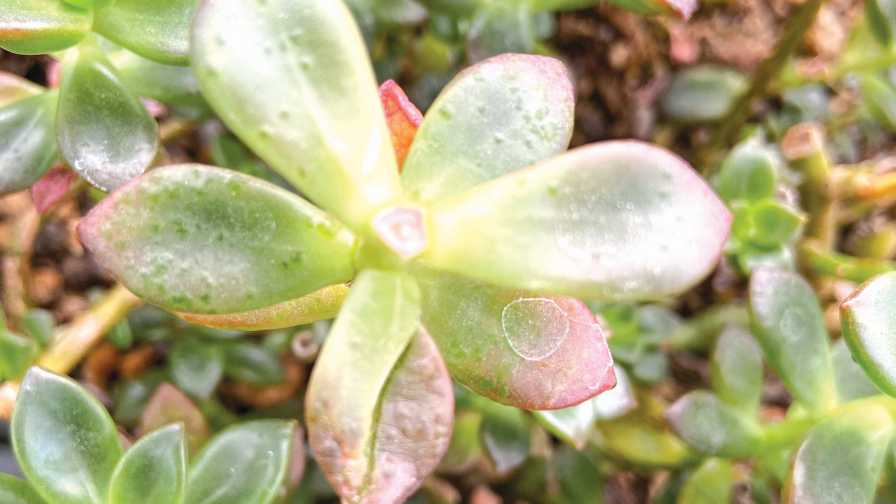Production Problems With Succulents Solved

Calcium deficiencies in succulents can result in leaf deformities such as curling, tip burn, discoloration, and death of leaf margins.
Photo by Carlos Martinez
The amazing plants known as succulents, which encompass thousands of species, get their name from the Latin word sucus, meaning juice or sap. They have been growing in popularity for quite some time. Their unique ability to store greater amounts of water than their non-succulent plant family members, holding it in reserve for extended periods of time, makes it possible for them to survive in arid environments and on windowsills, coffee tables, and refrigerator tops everywhere.
The thousands of succulent species are classified into several families. Nevertheless, they have some common characteristics that explain more of their distinctiveness.
An important characteristic of these remarkably versatile plants is their unique metabolism. Understanding how it functions in succulents can aid in growth and care. Crassulaceae Acid Metabolism, also known as CAM photosynthesis, is the process the plant uses to convert sunlight to energy. It has two separate phases: a phototroph or (daytime/light phase) and a synthetic (nighttime/dark phase). This is how the plant breathes.
Check Out a Guide to Guard Against Pests and Disease in Succulents
During the phototroph/day phase, the plant keeps its stomata (openings/pores in plant tissue) closed to avoid water loss called transpiration. Throughout the synthetic/night phase, the plant opens its stomata, losing some moisture to collect CO2 from the atmosphere and to release oxygen as a waste product. This gas exchange enables photosynthesis. With this rudimentary knowledge of succulents, we can look at proper care recommendations to prevent problems.
Consider Drainage for Growing Media
Choosing a suitable substrate is the first step toward ensuring healthy plant growth. Succulent substrate should be well-draining, with some moisture-retention capacity that dries quickly with no more than two to three days between irrigations. Recommended substrates include:
- 30%-60% Peat Moss
- 30%-60% Coconut Fiber
- 20%-40% Coarse Sand
- 10%-20% Volcanic/Igneous Rock (ground – red or black)
- 10%-20% Agrolite (agricultural lighting)
Irrigate Just Enough
Irrigation is the second step toward ensuring healthy plant growth. Succulents are not plants that require low water; they are plants that require less frequent watering. Less frequent watering should be heavy, as 25% to 35% of the water should percolate through the soil, limiting the build-up of fertilizer salts and other salts from accumulating, which could damage roots.

When succulents are over-watered, edema symptoms such as bumps or blisters can often be seen on the upper leaf surfaces.
Photo by Carlos Martinez
Another important factor of irrigation is to avoid watering above the foliage. All succulent species are susceptible to bacterial growth and tissue damage if their foliage is watered and wet. In fact, over-watering is the cause of most succulent problems, and the number one cause of succulent death.
Easy Does it With Fertilization
When fertilizing succulents, it’s important to keep in mind they only consume low levels of the nutrients, so it’s important not to over-fertilize. The fertilizer should include microelements with an EC of no more than 1.5 and a pH of 6.3 to 6.6. Examples of this are 15-15-15, 17-17-17, 20-20-20, or 10-20-20. The nitrogen content should never be higher than the phosphorus and potassium contents, and the application should not exceed two times per week. Once per week is enough for plant development and longevity.
Like nutrient application, hormone use can be harmful if used improperly, especially because of the slow growth of succulents and their two-phase metabolism mentioned earlier. If doses are used at the right times, it helps to grow a better-quality plant at a faster rate. Succulents require considerably less amounts of hormone than their non-succulent family members.
Use Hormones Properly
One of the most common and challenging succulent production problems is their slow growth. Patience is a virtue, but succulent growth can test even the most understanding growers. Adequate fertilization and proper hormone application can improve plant quality and encourage faster development.
The table below gives examples of hormones and their influences, including root stimulation as well as growth activation and development.










